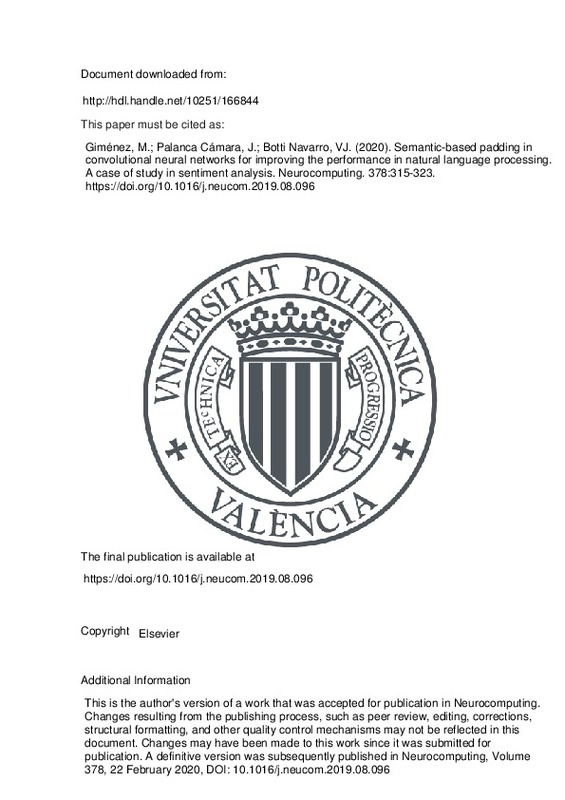Ye, Q., & Doermann, D. (2015). Text Detection and Recognition in Imagery: A Survey. IEEE Transactions on Pattern Analysis and Machine Intelligence, 37(7), 1480-1500. doi:10.1109/tpami.2014.2366765
Zhao, W., Chellappa, R., Phillips, P. J., & Rosenfeld, A. (2003). Face recognition. ACM Computing Surveys, 35(4), 399-458. doi:10.1145/954339.954342
Li, P., & Mao, K. (2019). Knowledge-oriented convolutional neural network for causal relation extraction from natural language texts. Expert Systems with Applications, 115, 512-523. doi:10.1016/j.eswa.2018.08.009
[+]
Ye, Q., & Doermann, D. (2015). Text Detection and Recognition in Imagery: A Survey. IEEE Transactions on Pattern Analysis and Machine Intelligence, 37(7), 1480-1500. doi:10.1109/tpami.2014.2366765
Zhao, W., Chellappa, R., Phillips, P. J., & Rosenfeld, A. (2003). Face recognition. ACM Computing Surveys, 35(4), 399-458. doi:10.1145/954339.954342
Li, P., & Mao, K. (2019). Knowledge-oriented convolutional neural network for causal relation extraction from natural language texts. Expert Systems with Applications, 115, 512-523. doi:10.1016/j.eswa.2018.08.009
Yoo, S., Song, J., & Jeong, O. (2018). Social media contents based sentiment analysis and prediction system. Expert Systems with Applications, 105, 102-111. doi:10.1016/j.eswa.2018.03.055
LeCun, Y., Boser, B., Denker, J. S., Henderson, D., Howard, R. E., Hubbard, W., & Jackel, L. D. (1989). Backpropagation Applied to Handwritten Zip Code Recognition. Neural Computation, 1(4), 541-551. doi:10.1162/neco.1989.1.4.541
W. Yin, K. Kann, M. Yu, H. Schütze, Comparative study of CNN and RNN for natural language processing, arXiv:1702.01923 (2017).
J. Villena Román, S. Lana Serrano, E. Martínez Cámara, J.C. González Cristóbal, Tass-workshop on sentiment analysis at SEPLN (2013).
Pang, B., & Lee, L. (2008). Opinion Mining and Sentiment Analysis. Foundations and Trends® in Information Retrieval, 2(1–2), 1-135. doi:10.1561/1500000011
Mohammad, S. M., & Turney, P. D. (2012). CROWDSOURCING A WORD-EMOTION ASSOCIATION LEXICON. Computational Intelligence, 29(3), 436-465. doi:10.1111/j.1467-8640.2012.00460.x
Kiritchenko, S., Zhu, X., & Mohammad, S. M. (2014). Sentiment Analysis of Short Informal Texts. Journal of Artificial Intelligence Research, 50, 723-762. doi:10.1613/jair.4272
T. Mikolov, K. Chen, G. Corrado, J. Dean, Efficient estimation of word representations in vector space, arXiv:1301.3781 (2013).
P. Bojanowski, E. Grave, A. Joulin, T. Mikolov, Enriching word vectors with subword information, arXiv:1607.04606 (2016).
Araque, O., Corcuera-Platas, I., Sánchez-Rada, J. F., & Iglesias, C. A. (2017). Enhancing deep learning sentiment analysis with ensemble techniques in social applications. Expert Systems with Applications, 77, 236-246. doi:10.1016/j.eswa.2017.02.002
Chen, T., Xu, R., He, Y., & Wang, X. (2017). Improving sentiment analysis via sentence type classification using BiLSTM-CRF and CNN. Expert Systems with Applications, 72, 221-230. doi:10.1016/j.eswa.2016.10.065
Y. Zhang, B. Wallace, A sensitivity analysis of (and practitioners’ guide to) convolutional neural networks for sentence classification, arXiv:1510.03820 (2015).
Y. Kim, Convolutional neural networks for sentence classification, arXiv:1408.5882 (2014).
Bengio, Y., Simard, P., & Frasconi, P. (1994). Learning long-term dependencies with gradient descent is difficult. IEEE Transactions on Neural Networks, 5(2), 157-166. doi:10.1109/72.279181
Zhang, W., Itoh, K., Tanida, J., & Ichioka, Y. (1990). Parallel distributed processing model with local space-invariant interconnections and its optical architecture. Applied Optics, 29(32), 4790. doi:10.1364/ao.29.004790
S.M. Mohammad, S. Kiritchenko, X. Zhu, NRC-Canada: building the state-of-the-art in sentiment analysis of tweets, arXiv:1308.6242 (2013).
J. Barnes, R. Klinger, S.S.i. Walde, Assessing state-of-the-art sentiment models on state-of-the-art sentiment datasets, arXiv:1709.04219 (2017).
Medhat, W., Hassan, A., & Korashy, H. (2014). Sentiment analysis algorithms and applications: A survey. Ain Shams Engineering Journal, 5(4), 1093-1113. doi:10.1016/j.asej.2014.04.011
M. Abadi, A. Agarwal, P. Barham, E. Brevdo, Z. Chen, C. Citro, G.S. Corrado, A. Davis, J. Dean, M. Devin, S. Ghemawat, I. Goodfellow, A. Harp, G. Irving, M. Isard, Y. Jia, R. Jozefowicz, L. Kaiser, M. Kudlur, J. Levenberg, D. Mané, R. Monga, S. Moore, D. Murray, C. Olah, M. Schuster, J. Shlens, B. Steiner, I. Sutskever, K. Talwar, P. Tucker, V. Vanhoucke, V. Vasudevan, F. Viégas, O. Vinyals, P. Warden, M. Wattenberg, M. Wicke, Y. Yu, X. Zheng, TensorFlow: Large-scale machine learning on heterogeneous systems, 2015, Software available from tensorflow.org.
[-]







![[Cerrado]](/themes/UPV/images/candado.png)


